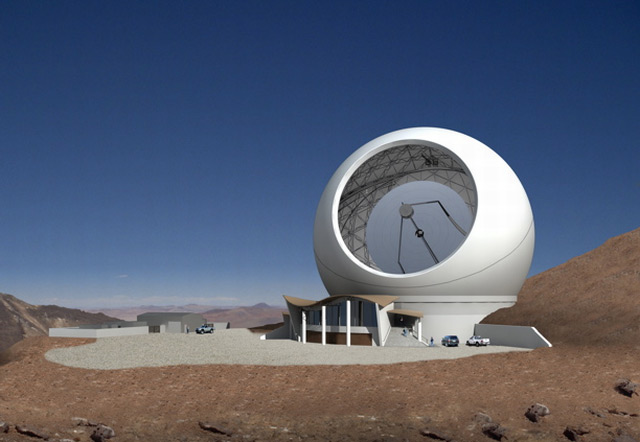New Telescope in Chile to Witness Birth of Galaxies

A new telescope facility in Chile isbeing designed to probethe universe for galaxies and young stars.
The Cerro Chajnantor AtacamaTelescope (CCAT), beingdeveloped by astronomers at Cornell University in Ithaca, N.Y., will bebuiltin northern Chile on a mountain in the Andes, at 18,400 feet (over5,600meters) above sea level. The telescope will be used by astronomersaround theworld to answer fundamental questions on the originof galaxies and the early evolution of the universe.
"The epoch of galaxy formation thatCCAT is going toexplore in a unique way is when most of the interesting things in theuniversestarted happening, as far as we are concerned," Riccardo Giovanelli,Cornell professor of astronomy and principal investigator for CCAT,said in arelease.
"The carbon in our bodies, thesilicon in ourcomputers, the gold in gifts we give a girlfriend or boyfriend ? allthesethings were made with stuff being produced when our galaxies wereborn,"Giovanelli explained. "Understanding that process is understanding howtheuniverse became sophisticated enough in a chemical way to producethings weenjoy now, like black-and-white movies and the stuff we use to buildtelescopes."
In a recent announcement, FrederickYoung, a Cornell alumnusand former director of the Cornell Society of Engineers, and a longtimesupporter of the project, pledged $11 million toward the design andconstruction of the CCAT telescope. [Earth'sMost Important Telescopes]
Cornell Provost Kent Fuchs calledCCAT "a greatadventure because of the spectacular science, as we create this cosmicsurveyor;and it's a great adventure because of the scale."
The 25-meter (82 feet) in diameterCCAT will employ largecameras and spectrometers to survey the sky at millimeter andsubmillimeterwavelengths of light, which will provide an unprecedented combinationofsensitivity and resolution across a wide field of view.
Get the Space.com Newsletter
Breaking space news, the latest updates on rocket launches, skywatching events and more!
With its ability to conductlarge-scale surveys of the sky,the project will complement the international Atacama Large MillimeterArray(ALMA) telescope, now under construction and also located in Chile'sAtacama desert. The facilities will be able to work inconjunction ? asCCAT discovers new sources, ALMA will be able to follow up withdetailedimages.
In August, the NationalResearch Council highly recommended the expansion of the CCATproject, andfurther recommended federal support for one-third of its constructioncost andoperations. The telescope also received endorsement from the Astro2010panel, anational panel appointed by the National Academy of Sciences that willdeterminepriorities in astronomy and astrophysics for the next decade.
The CCAT is a joint project ofCornell University, theCalifornia Institute of Technology with its Jet Propulsion Lab inPasadena,Calif., the University of Colorado, a Canadian consortium led by theUniversityof British Columbia, the University of Cologne and the University ofBonn inGermany, as well as Associated Universities Inc., a nonprofitorganization thatoperates national and international facilities, and the U.K. AstronomyTechnology Center.
Join our Space Forums to keep talking space on the latest missions, night sky and more! And if you have a news tip, correction or comment, let us know at: community@space.com.

Space.com is the premier source of space exploration, innovation and astronomy news, chronicling (and celebrating) humanity's ongoing expansion across the final frontier. Originally founded in 1999, Space.com is, and always has been, the passion of writers and editors who are space fans and also trained journalists. Our current news team consists of Editor-in-Chief Tariq Malik; Editor Hanneke Weitering, Senior Space Writer Mike Wall; Senior Writer Meghan Bartels; Senior Writer Chelsea Gohd, Senior Writer Tereza Pultarova and Staff Writer Alexander Cox, focusing on e-commerce. Senior Producer Steve Spaleta oversees our space videos, with Diana Whitcroft as our Social Media Editor.









